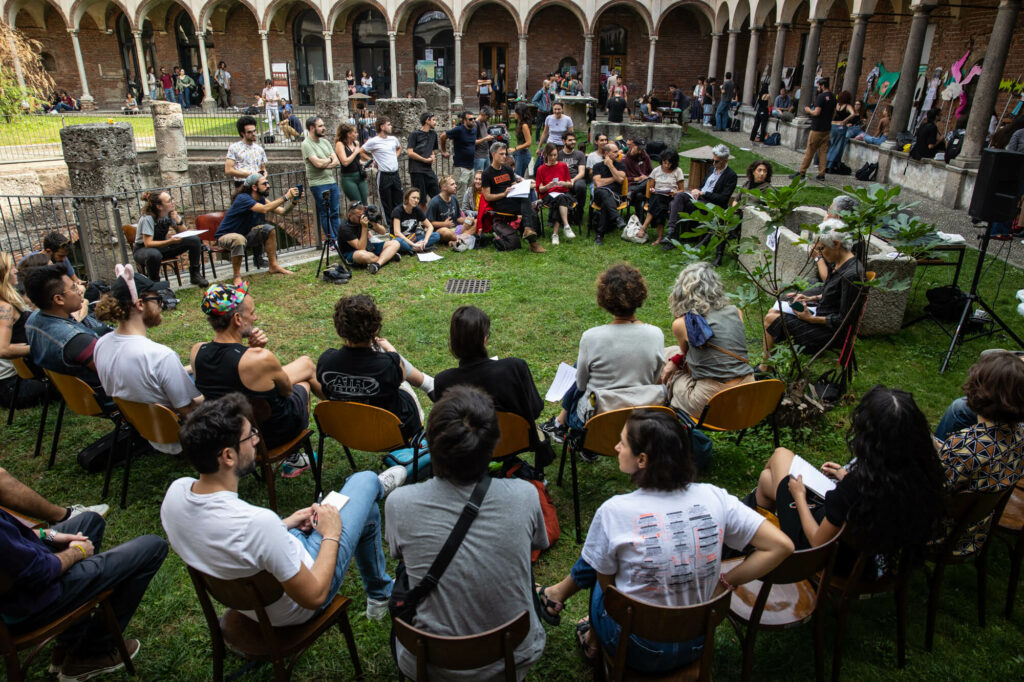

The World Congress for Climate Justice took place in Milan (Italy) on October 12-15 this year. This radical event brought together more than 60 collectives, associations and political groups that make up the dense climate justice archipelago. The main idea was to create the ‘First International for Climate Justice‘. One of the peculiarities of the meeting, besides being the first in Italy with a global and not only European scope, is that it was not a counter-summit convened to oppose some official gathering such as UN-backed Conference of the Parties (it preceded the COP 28 in Dubai by six weeks). Rather, it was self-organised by grassroots movements with the aim of comparing goals, strategies and practices from a unitary perspective.
A critical assessment of the first five years of the cycle of struggles was proposed: things started to get heated due to the impetus of Greta Thunberg and the Fridays For Future movement in 2019. Then the scene evolved in what is today a plurality of groups fighting for climate justice on a global level. The global strike on March 15, 2019, was a historical day, where millions of people, mostly youth, took to the streets for their future, to start the first and largest climate movement on an international scale. At first, the mobilisation was driven by the media space granted to Greta by those who tried to instrumentalise her. However, as soon as Greta’s speeches became more radical and in open opposition to the capitalist model of development – and until her arrest in London, last October – the media space granted to the Swedish woman, was greatly reduced. Subsequently, first the pandemic and then the war in Ukraine almost made her figure disappear from the screens. The same goes for the attention accorded to Climate Justice.
These were, among others, the causes of the “crisis” that Fridays for Future currently goes through, as exemplified by the lower participation in the last global strikes. However, the young people who had taken part in the oceanic marches have over time sedimented narratives and discourses that have re-emerged in a multitude of political groups that, through different strategies, forms and practices, animate today’s struggles for climate justice around the world. The phenomenon is not only quantitative, but is above all qualitative: the new generation of climate activists has connected with territorial struggles, the world of labour, and with decolonial and feminist movements. What previously seemed like an insurmountable problem – presented by the hyperobject of climate change – now appears to be a plan of conflict that can be practised in close proximity to one’s daily experience, a political framework through which many conflicts can connect.
The shared starting point for the convergence among movements during the four days of assemblies was the blatant failure of “market solutions” to the climate crisis, that is, the proposals that have come out of the various COPs over the past 25 years. As many ecological economists have shown through the years, and in different geographic contexts, the policy of pricing carbon to submit the atmosphere as a whole to the market logic is at radical odds with the necessity to reduce actual CO2 emissions and shrink the societal metabolism. What activists repeatedly stated throughout the World Congress is that recent data allow for a new framing of the main problem: it is not that “we” are moving too slowly towards the desired promised land; it is that “we” are running fast in the wrong direction. After all, more CO2 has been emitted after 1990 — the baseline year of the Kyoto Protocol — than in the period 1750-1990.
For this reason, every group agreed on positioning the fight against global warming within the anti-capitalist camp, since the root and overall causes of the ecological crisis are identified in the dominant socio-economic model. This attitude has engendered a new perspective on the link between inequalities and climate change, a topic well known to ecological economists. If, before the wave of strikes in 2019, “common but differentiated responsibilities” were measured along the North-South political axis – the argumentative line being that those countries which had contributed the least to global warming were suffering the most from it – things look different now. Although this view is still very present – and rightly so – climate inequalities are increasingly seen as an issue that cuts across national communities in a seemingly old-fashioned social question: the guilt for excessive emissions is to be firmly allocated to the carbon billionaires (when it comes to investment decisions) and to the weight of the consumption life-styles of the 1%.
Another element of the Congress was a critique of so-called “white ecologism”, an issue introduced by the MAPA (Most Affected People and Areas) movements present in Milan. Such a critique, in fact, cannot be limited only to fossil capitalism, but must embrace all forms of coercive grabbing and despoiling of land resources by multinational corporations.
At the European level, on the other hand, student groups rallied around the End Fossil campaign, which aims to “decarbonise schools and universities”. It has been active since last May and has targeted agreements between educational institutions and the fossil industry. The next international wave of mobilisations will be in late-November. Several occupations have already been announced.
Let me finish where I began. The World Congress for Climate Justice formed the infrastructure of the First Climate Activist International, that is, a permanent coordination of all climate-related struggles on Earth. These struggles form a plural but unitary subject, on the one side antagonistic to the dominant socio-economic model, while on the other side prefiguring a new ecological form of sharing space and resources among living beings.



